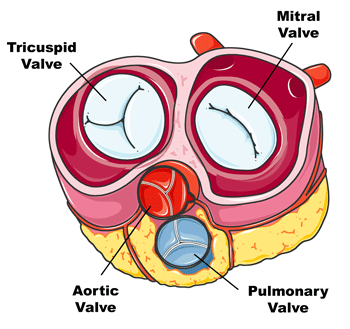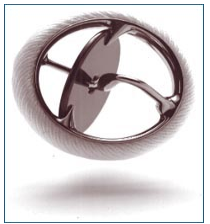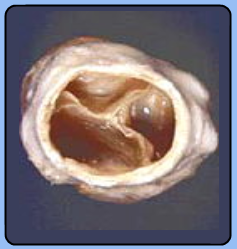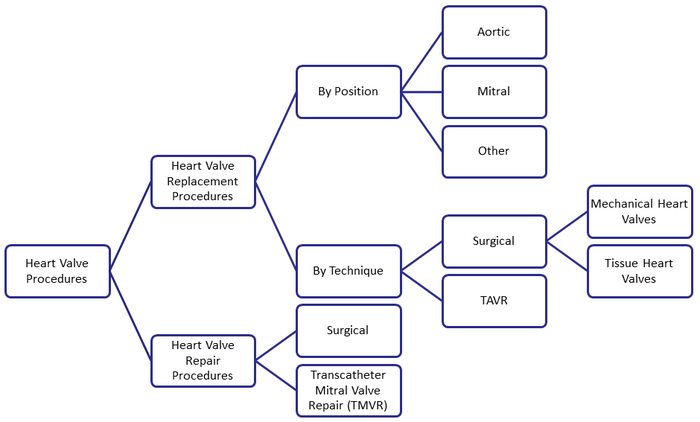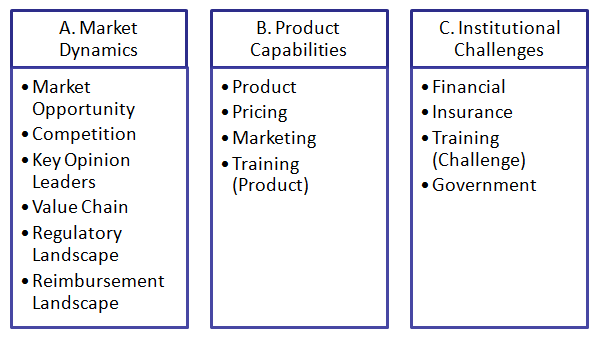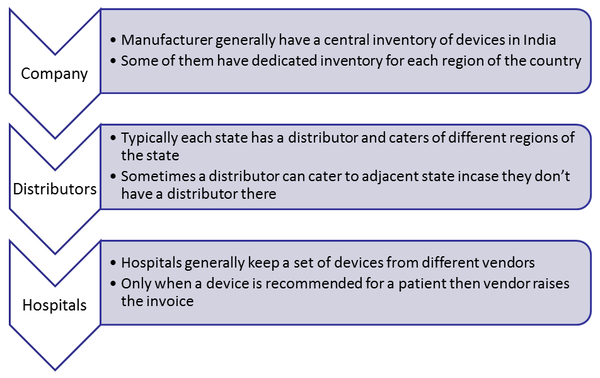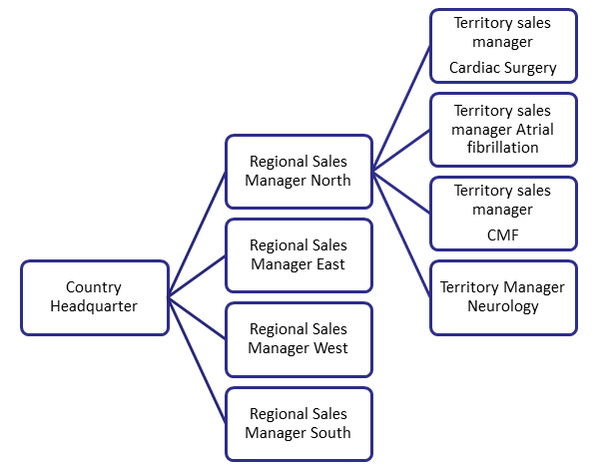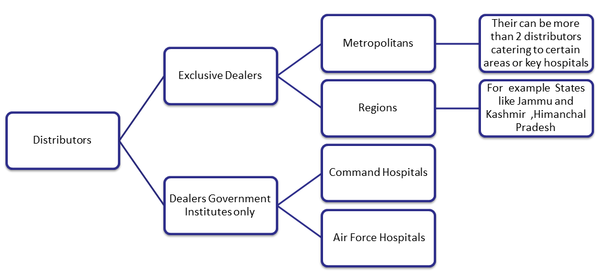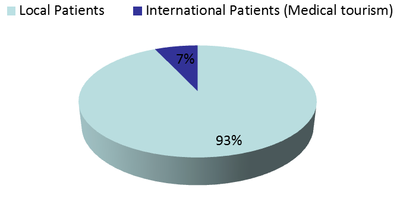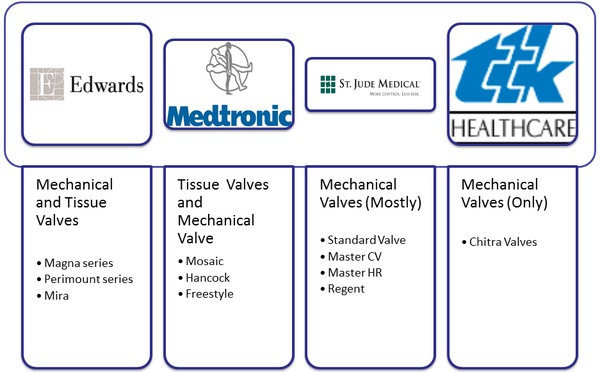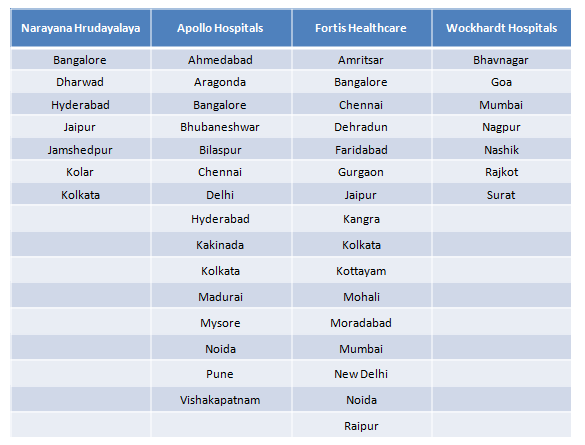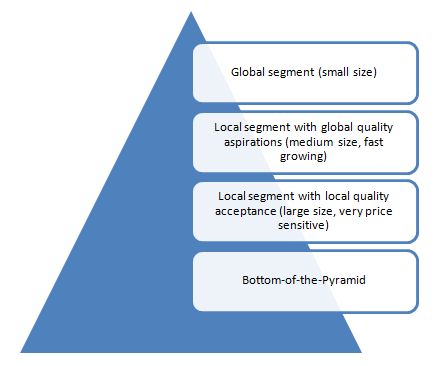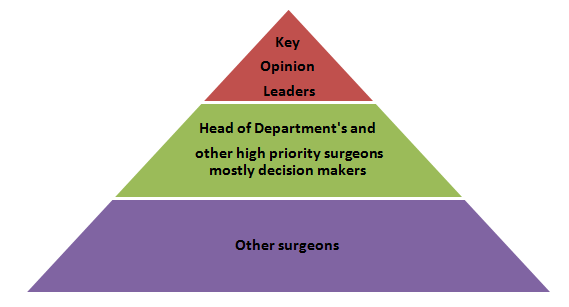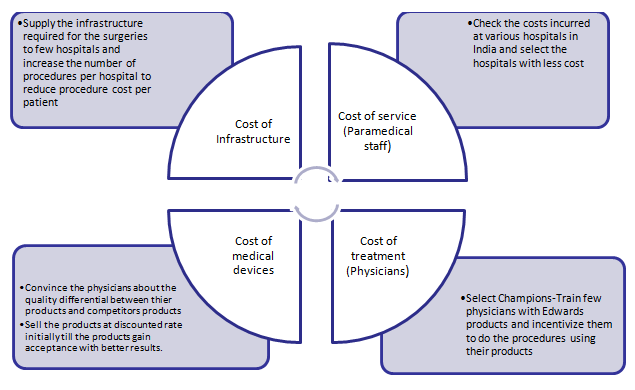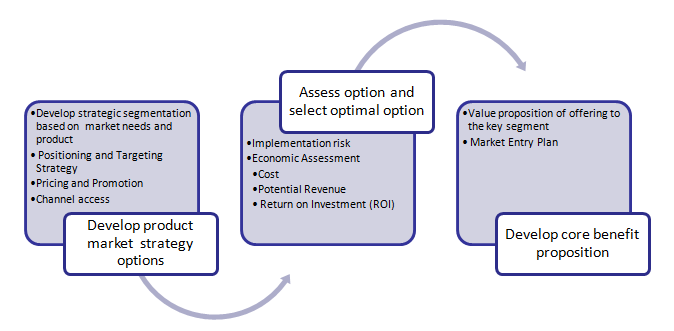Difference between revisions of "Strategic Insights:Heart Valve Replacement Market - India"
(No difference)
|
Latest revision as of 04:55, 29 May 2012
Contents
- 1 Introduction
- 2 Current Worldwide Market
- 3 Market in India
- 3.1 Strategic Outlook
- 3.2 Overview of market
- 3.3 Regulatory landscape
- 3.4 Reimbursement landscape
- 3.5 Technology landscape
- 3.6 Distribution landscape
- 3.7 Pricing landscape
- 3.8 Key hospitals & institutions
- 3.9 Key Opinion Leaders
- 3.10 Market Drivers
- 3.11 Recent Trends
- 3.12 Recent Developments
- 4 Key Players
- 5 Recommendations
- 6 Strategy formulation
Introduction
For blood to go in only one direction, forward, it must pass through the heart valves, which function as one-way doors, opening and shutting with each beat of the heart. Just as there are four chambers to the heart, there are four heart valves. Blood must pass through one of these valves each time it leaves a chamber.
The Four Heart Valves:
- Tricuspid: The tricuspid valve is named because it has three leaflets. It is located between the right atrium and right ventricle.
- Pulmonary: The pulmonary valve is named because it is located below the pulmonary artery, between the right ventricle and the pulmonary artery.
- Mitral: The mitral valve is named because it looks like an upside down bishop's hat or mitre. It is the only heart valve with two leafets; all of the others have three. It is located between the left atrium and left ventricle.
- Aortic: The aortic valve is named because it is located below the aorta, between the left ventricle and aorta.
The two valves located between the atria and ventricles, the tricuspid and mitral valves, are known as atrioventricular valves. The two other valves, the pulmonary and aortic, are sometimes called semilunar valves, because each of those valves has leaflets that are shaped like half-moons.
Sources:Alliance Heart Institute,Drexel.edu
Types of heart valves
When someone has to have a heart valve replaced, there are a few things that are done to determine what type of valve the patient will recieve. The patient could recieve one of the following valves: mechanical valves, tissue valves, homograft valves, or allograft valves. These all have there advantages and disadvantages.
Tissue Valves: A tissue valve is another field of valves that are taken from an animal and put into human hearts. These kinds of valves are chemically treated for safety and are prepared for the human heart (St. Jude Medical, Inc., 2007). Since these valves are weak, they are reinforced with a frame or stent to make them stronger, and to support the valve. The valves that aren’t reinforced are called stentless valves (St. Jude Medical, Inc., 2007).
These types of valves aren’t a good choice for younger patients because they wear out quickly. They wear out because they stretch when the demand of blood flow increases (Aortic valve replacement, 2007). Another reason as to why they aren’t used often is because when these valves wear out, the patient will have to under go another operation to get a new valve implanted to replace the previous one. These valves last, on average, 10-15 years in the less active patients such as the elderly, while in the younger and more active patients, they wear out a lot faster (Aortic valve replacement, 2007).
Mechanical Valves: Mechanical valves are designed to mimic a real heart valve (St. Jude Medical, Inc., 2007) and to outlast the patient (Aortic valve replacement, 2007). All versions have a ring to support the leaflets (flaps) like a natural valve and has a thin polyester mesh cuff on the circumference of the valve for easier implantation. This is for easier implantation (St. Jude Medical, Inc., 2007). These valves are not controlled electronically but naturally. As the heart beats, the mechanical valve opens and closes (St. Jude Medical, Inc., 2007). These valves have been proven to last several hundred years by being stress-tested (Aortic valve replacement, 2007).
Homograft Valves: The third type of valve is a homograft valve. This a valve that is taken form a human donor (St. Jude Medical, Inc., 2007; Encyclopedia of Medicine, 2006).These donor valves are only given to patients who will deteriorate rapidly because of a narrowing of the passageway between the aorta and that left ventricle (Encyclopedia of Medicine, 2006) This type of valve is better for pregnant women and children (St. Jude Medical, Inc., 2007. Unlike most valves, this type of valve does not require anticoagulation therapy over a long time (long-term) (St. Jude Medical, Inc., 2007).Durability of a homograft is approximately the same as a tissue valves (Aortic valve replacement, 2007).These valves are sometime, but rarely, taking from the patients own pulmonic valve (Encyclopedia of Medicine, 2006).
Allograft Valves:The fourth type of valve is an allograft valve. These valves are usually taken from pig's aortic valve (Encyclopedia of Medicine, 2006). They are chemically treated before they are put into a human heart. The life span of one of these valves is about 7-15 years, depending of the patient (Encyclopedia of Medicine, 2006). Because of the short life span of this valve, it is generally given to the older patients (Encyclopedia of Medicine, 2006).
Source:odec.ca
Disorders treated by heart valves
- Valvular Stenosis:This occurs when a valve opening is smaller than normal due to stiff or fused leaflets. The narrowed opening may make the heart work very hard to pump blood through it. This can lead to heart failure and other symptoms (see below). All four valves can be stenotic (hardened, restricting blood flow); the conditions are called tricuspid stenosis, pulmonic stenosis, mitral stenosis or aortic stenosis.
- Valvular Regurgitation:This occurs when a valve does not close tightly. If the valves do not seal, some blood will leak backwards across the valve. As the leak worsens, the heart has to work harder to make up for the leaky valve, and less blood may flow to the rest of the body. Depending on which valve is affected, the conditioned is called tricuspid regurgitation, pulmonary regurgitation, mitral regurgitation or aortic regurgitation.
Source:Medicinenet
Heart valve procedures
Procedure of Heart Valve Surgery
Heart valve surgery means repair or replacement of the diseased valves. In the surgery, some valves are repaired or mended to do its work properly. Replacement means removal of the diseased valves by a new valve. The procedures of heart valve surgery are :
- Valve Repairing : In the valve repair surgery, a ring is sewn around the opening of the valve to make tighter. The surgeons may cut the other parts or may separate and shorten it to help the valve open and close right.
- Valve Replacement : Sometimes by mending the valves, it is not possible to cure the unhealthy valve, and then replacement is required to get back its normal function. A prosthetic valve is used to replace. There are two types of prosthetic valves.
- Mechanical valves : These types of valves are made from man-made materials. While heart surgeons’ use this valve, lifetime therapy with an anticoagulant is prescribed to the patient.
- Biological (tissue) valves : The surgeons take biological valves from pig, cow or human donors. The longevity of biological valves is less than the mechanical valves.
Source:Indian-medical-center
Heart valve procedures by technique
Transcatheter Aortic Valve Implantation (TAVI)
Description This technique involves insertion of a miniaturized valve through a catheter from the groin. The deployed valve is later inflated at the site of the aortic valve. The entire procedure is conducted under general anesthesia and takes about an hour. It is a non-surgical procedure. In TAVI inner organs are accessed via needle-puncture of the skin, rather than by using a scalpel.
Procedures in India TAVI is still in nascent trial stage in India. In mid of March, a team of doctors at Delhi's Fortis Hospital headed by Dr Ashok Seth operated three patients using TAVI.
Cost of surgery in India The cost of procedure is 29,350 USD which include the cost of valve 21,500 USD (approx).
Prevalence After the age of 75 years, 5% population is at the risk of developing a problem in their heart valve, out of which 35% are not suitable for surgery. If not treated, 50% of them will not survive for more than two years.
Source:Indiatimes
Ross Procedure
The Ross Procedure is a type of specialized aortic valve surgery where the patient's diseased aortic valve is replaced with his or her own pulmonary valve. The pulmonary valve is then replaced with cryopreserved cadaveric pulmonary valve. In children and young adults, or older particularly active patients, this procedure offers several advantages over traditional aortic valve replacement with manufactured prostheses.
Source:University of Southern California

- 1,500 Ross procedures are performed annually on a global basis. In US, this number is around 1,000.
Current Worldwide Market
Market size
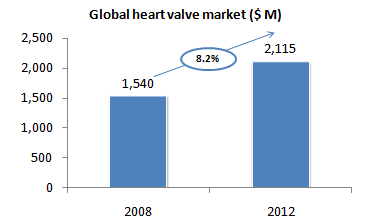
Trends
- Aortic Valve segment represents 55% of the overall market. However, with 35-50% of patients suffering from severe aortic stenosis considered at high risk for surgery, the current number of patients eligible for TAVI procedures is 200,000 worldwide.
- The TAVI segment thus represents a $2B market opportunity. According to various sources, this market size will be reached in 2014.
- The Brazilian, Russian, Indian, and Chinese (BRIC) heart valve device market—comprising sales of heart valve replacement (mechanical, tissue, and transcatheter aortic valve replacement [TAVR]) and heart valve repair (annuloplasty) devices—was valued at nearly $180 million in 2011 and will expand through 2016, driven primarily by rising heart valve procedure volumes.
- Rapid economic growth and an aging population, which are increasing both the prevalence of valvular heart disease and patients’ ability to pay for treatment, constitute the primary drivers of growth in the BRIC heart valve device market.
- The patient population will also expand as government funding for health care infrastructure improves the accessibility and affordability of the procedures for patients across all BRIC nations.
- Rising penetration of tissue heart valves will contribute further to market growth due to the premium price of these devices compared to mechanical heart valves.
Sources:MRG Report,Symetis Website
Recent Approvals
| Date | Company | Country | Product Approved | Source |
| Apr 2012 | St. Jude Medical | Japan | The new Trifecta aortic stented, pericardial tissue valve has been implanted in procedures atOsaka University Hospital and Saitama Medical University International Medical Center | Medcity News |
| Nov 2011 | Edward Lifesciences | US | The Sapien Transcatheter Heart Valve will provide some people with this condition who can’t undergo open heart surgery with the option of valve replacement | Wallstreet Journal |
| July 2011 | Sorin Group | Europe | Mitroflow Aortic Pericardial Heart Valve | Sorin |
| Jan 2011 | Sorin Group | Europe | Innovative Self-Anchoring Aortic Heart Valve, Perceval™ S | Sorin |
| May 2010 | CryoLife | US | Cryovalve SG Pulmonary Human Heart Valve (and Conduit) | FDA |
Market in India
Strategic Outlook
Level 1
Level 2
Overview of market
Current size
- The Indian market for heart valves was about 30,000 a year and a sizeable portion of that is being met by the TTK-Chitra valves.
Source:Senior Executive at TTK Chitra Hindu Article
Regulatory landscape
Overview
- Indian government is working on a comprehensive regulatory framework for the medical device sector because it has lacked a formal regulatory system for many years. Medical devices are currently either regulated as drugs or simply left unregulated.
- In June 2009, the Drug Consultative Committee (DCC) and the Drug Technical Advisory Board (DTAB) approved new formal regulations for India's medical devices sector. The Health Ministry is set to issue the notification of these new regulations in the near future.
According to the final draft of the newly proposed regulations, all medical devices have been broadly classified into the following categories:
- Class A Devices: Low risk devices that include gloves and operating room utensils;
- Class B Devices: Low to medium risk devices such as needles, surgical knives, and syringes;
- Class C Devices: Moderate to high risk devices such as radiation equipment and heart–lung machines
- Class D Devices: Very high risk and life supporting devices such as implantable pacemakers and defibrillators.
Recent approvals
Heart Valves notified as “drugs”: As per the notice dated 16/May/2005 from The Ministry of Health and Family Welfare, Govt. of India has notified Heart Valve devices to be considered as drugs under Section 3, Clause (b) . Sub clause (iv) of the Drugs and Cosmetics Act, notification number s.o.1468 (E). CDSCO: Medicines in India are regulated by CDSCO - Central Drugs Standard Control Organization. Under Ministry of Health and Family Welfare. Headed by Directorate General of Health Services CDSCO regulates the Pharmaceutical Products through DCGI - Drugs Controller General of India at Chair.
| Registration Certificates issued for the Heart Valves along with their manufacturing sites and Indian Authorized agents in since 2010 | ||||||
| Date | Name of Indian Agent | Name of Manufacturer | Name of the Device | File No. | R. C. No. | Validity of the Registration Certificate |
| Jan. 2012 to Feb 2012 | M/s. St. Jude Medical India Private Limited, Plot No. 18 & 19 Laxminagar, behind TB Hospital, Hyderabad-500038 | M/s. St. Jude Medical Puerto Rico LLC, Lot 20-B, St. Cagaus Puerto Rico 00725 | 1. St. Jude Medical Mechanical Heart Valve 2.SJM Master Series (Rotatable)-Aortic + 9 | 31-28-MD/2006-DC (Re-Reg. 2_ | MD-28 | 30-06-2015 |
| Jan. 2011 to 20th December 2011 | M/s India Medtronic Pvt. Ltd., 1241, Solitaire Corporate Park, Building Number 12, 4th Floor, Anheri-Ghatkopar Link Road, Andheri (E), Mumbai- 400094 | M/s Medtronic Inc., 710 Medtronic Parkway N. E. Minneapolis MN 55432 USA having manufacturing premises at M/s Medtronic ATS Medical Inc., 3905 Annapolis Lane, Suite 105 Minneapolis, MN – 5547, USA | 2. Open Pivot Aortic Valved Graft (AVG) | 31-892-MD/2010-DC | MD-893 | 31-12-2014 |
| Jan. 2011 to 20th December 2011 | M/s Edward Lifesciences (India) Pvt. Ltd., E.F. 201-204, Remi Biz Court, Plot No. 9, Off Veera Desai Road, Andheri West, Mumbai- 400058 | M/s Edward Lifesciences LLC, One Edwards Way, Irvine CA, USA 92614-5686 | 1. Carpentier-Edwards Bioprosthetic Valved Conduit | 31-93-MD/2006-DC (Re-Registration 2010) (End. 1) | MD- 93 | 31-01-2013 |
| Jan. 2011 to 20th December 2011 | M/s Edward Lifesciences (India) Pvt. Ltd., E.F. 201-204, Remi Biz Court, Plot No. 9, Off Veera Desai Road, Andheri West, Mumbai- 400059 | M/s Edward Lifesciences LLC, One Edwards Way, Irvine CA, USA 92614-5687 | 2. Edwards MC Tricuspid Annuloplasty System | 31-93-MD/2006-DC (Re-Registration 2010) (End. 1) | MD- 94 | 31-01-2014 |
| Jan. 2011 to 20th December 2011 | M/s India Medtronic Pvt. Ltd., 1241, Solitaire Corporate Park, Building Number 12, 4th Floor, Anheri-Ghatkopar Link Road, Andheri (E), Mumbai- 400093 | M/s Medtronic Inc., 710 Medtronic Parkway N. E. Minneapolis MN 55432 USA having manufacturing premises at M/s Medtronic Mexico S. de R.L de C.V. Avenida paseo del Cucapah 10510, Parque Industrial EI Lago, Tijuana, B.C. 22570< Mexico | 1. Sprinter rapid Exchange Balloon Dilatation Catheter | 31-381-MD/2007-DC (Re-Reg. 2010) | MD-381 | 14-02-2014 |
| Jan. 2011 to 20th December 2011 | M/s India Medtronic Pvt. Ltd., 1241, Solitaire Corporate Park, Building Number 12, 4th Floor, Anheri-Ghatkopar Link Road, Andheri (E), Mumbai- 400094 | M/s Medtronic Inc., 710 Medtronic Parkway N. E. Minneapolis MN 55432 USA having manufacturing premises at M/s Medtronic Mexico S. de R.L de C.V. Avenida paseo del Cucapah 10510, Parque Industrial EI Lago, Tijuana, B.C. 22570< Mexico | 2. Sprinter legent RX Balloon Dilatation Catheter | 31-381-MD/2007-DC (Re-Reg. 2010) | MD-382 | 14-02-2015 |
| Jan. 2011 to 20th December 2011 | M/s India Medtronic Pvt. Ltd., 1241, Solitaire Corporate Park, Building Number 12, 4th Floor, Anheri-Ghatkopar Link Road, Andheri (E), Mumbai- 400095 | M/s Medtronic Inc., 710 Medtronic Parkway N. E. Minneapolis MN 55432 USA having manufacturing premises at M/s Medtronic Mexico S. de R.L de C.V. Avenida paseo del Cucapah 10510, Parque Industrial EI Lago, Tijuana, B.C. 22570< Mexico | 3. Melody Transcatheter Pulmonary Valve | 31-381-MD/2007-DC (Re-Reg. 2010) | MD-383 | 14-02-2016 |
| Jan. 2011 to 20th December 2011 | M/s. St. Jude Medical India Private Limited, A & B, 2nd Floor, Brij Tarang, Greenland, Begumpet, Hyderabad-500016 | M/s. St. Jude Medical Cardiology Division Inc, DBA 177 County Rod, B East St. Paul, MN 55117, USA | Trifecta Valve Aortic (19mm-27mm) | 31-26-MD/2006-DC (Re-Reg. 2009 (End 02) | MD-26 | 30-06-2012 |
Reimbursement landscape
- Aarogyasri in Andhra Pradesh State
- Jeevandayi Yojana in Maharashtra State
- Kalignar's Insurance Scheme
Aarogyasri
- It is a flagship scheme of all health initiatives of the State Government with a mission to provide quality healthcare to the poor. The aim of the Government is to achieve "Health for All" in Andhra Pradesh state.
- In 2007, the Andhra Pradesh government launched ’Aarogyasri’, a community health insurance scheme for the poor (Under this scheme, the hospitals received a fixed amount for valve replacement operations).
- The Maharashtra state government provides financial assistance to people falling in the below poverty line (BPL) category for treatment of various diseases.
- Under this scheme, doctors perform major operations within an upper limit of Rs 1.5 lakh.
Kalignar's Insurance Scheme
- Tamil Nadu launched the “Kalaignar’s Insurance Scheme for Life Saving Treatments” for families with an annual income less than Rs. 72,000.
- Each family will enjoys benefits up to Rs. 1 lakh for certain procedures in private hospitals and pay wards in government hospitals.
- Private insurance company Star Insurance, contracted to implement the scheme, has entered into contracts with a number of hospitals in private health care centres and hospitals throughout the State. There will be a minimum of six hospitals in each district and 15 hospitals in the major cities. The government will pay the premium of Rs. 500 per annum. A total of Rs. 517.30 crore is the allotment for the current financial year.
Reimbursement rates
In India, the reimbursement rate for procedures varies from one insurance company to another. Typically, Heart Valve Replacement procedure falls under major illness category. The amount of reimbursement is typically dependent on the sum assured.
- United India Assurance - Pre and Post Hospitalisation expenses payable in respect of any illness shall be the actual expenses incurred subject to a maximum of 10% of the Sum Insured whichever is less. For major illnesses, the expenses are settled on a co-pay of 80:20 ratio. The co-pay of 20% will be charged as a total package applicable on the admissible claim amount.
- Life Insurance Corporation - For major cardiovascular surgical procedures like Valve replacement surgery, open heart surgery for vale repair and heart by-pass surgery, up to 100% of sum assured could be claimed.
- ICICI Lombard Insurance - For critical illnesses like Coronary artery bypass graft surgery and Heart valve replacement surgery, the insured is entitled to the lumpsum benefit of the 100% of the sum insured for. The insurance sum may vary between $12,000 - $24,000.
- The reimbursement for medical devices like valve, stent, pacemaker etc. are evaluated on a case-to-case basis.
Source: UIA, LIC, ICICI Lombard
Technology landscape
An artificial heart valve is a device implanted in the heart of a patient with heart valvular disease. Natural heart valves become dysfunctional for a variety of pathological causes. When one of the four heart valves malfunctions, the medical choice may be to replace the natural valve with an artificial valve.
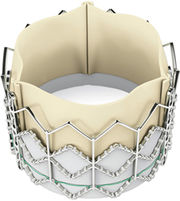
There are two main types of artificial heart valves:
- Mechanical valves - prosthetics designed to replicate the function of the natural valves of the human heart.
- Biological valves - valves of animals, like pigs, which undergo several chemical procedures in order to make them suitable for implantation in the human heart.
One of the greatest biomedical engineering challenges today is to develop an implantable device that resists the natural conditions to which heart valves are subjected, without eliciting host reactions that would impair their function. Currently, no artificial heart valve device, either mechanical or tissue-derived, fulfills the required prerequisites for an ideal heart valve.
Regenerative medicine approaches to heart valve replacement:
Regenerative medicine is based on principle of using the patient’s own cells and extracellular matrix components to restore or replace tissues and organs that have failed. Modern approaches to heart valve regenerative medicine include several research methodologies with the most intensely researched approaches being:
- the use of decellularized tissues as scaffolds for in situ regeneration
- construction of tissue equivalents in the laboratory before implantation, and
- use of scaffolds preseeded with stem cells.
The regenerative medicine approach is however still in its nascent stages.
Future and perspesctives:
Effective treatments of valvular disease continues to present multiple challenges. The exciting lines of investigation in this area are:
- Finding causes and developing nonsurgical therapy approaches for valvular disease
- Improvement of current artificial devices
- Regenerative medicine approaches
Ross procedure
- This technique involves replacing diseased aortic and mitral vales with the patient's own pulmonary valve and valves collected from cadavers replace the pulmonary valve.
Arkalgud Sampath Kumar- Biography
Percutaneous Transcatheter Aortic Valve Implantation (TAVI)
- In TAVI, a replacement valve is passed through a hole in the groin by a puncture of the femoral artery and advanced up to the ascending aorta of the patient. It substitutes for a more invasive procedure in which the chest is opened. The survival is equivalent, but the risk of stroke is higher.
Dr. Ashok Seth, Fortis Healthcare, Delhi
Transcatheter Pulmonary Valve (TPV) Therapy
- Transcatheter pulmonary valve therapy or Percutaneous pulmonary valve implantation (PPVI) treats narrowed or leaking pulmonary valve conduits without open-heart surgery.
- With transcatheter pulmonary valve therapy, a catheter (a thin, hollow tube) holding an artificial heart valve is inserted into a vein in the leg and guided up to the heart. The heart valve is attached to a wire frame that expands with the help of balloons to deliver the valve. Once the new heart valve is in position, it begins to work immediately.
Source:Medtronic
Distribution landscape
Value Chain- Heart Valves
Sales Force Structure
Distributors & Stockists
Distribution Channel:
- Distribution channel generally consists of the company, distributor & Hospital while Doctors being the key influencer regarding which valves should be procured. Patients are rarely aware of brands generally go by the Doctors choice which is conjunction with their paying capacity & need of the surgery.
- Big private chain of Hospitals sometimes bypass distributor and directly deal with manufacturing company. Discussed in detail in pricing section.
- Distributors are majorly concentrated in metropolitans like New Delhi, Chennai, Mumbai, ,Kolkata ,Bangalore, Hyderabad etc. and also cater to regions nearby.
- Commercial activities are done by stockist while companies sales force provide technical support to doctors , addresses the all issues faced to streamline the process & take feedback at every level in supply chain.
Distribution channel at government hospitals:
- Hospital floats a tender on basis of their requirement. The stockist quote price for 6 months/ yearly for heart valves. Generally authorized stockist gets discount on the product from the company hence are able to bag deals easily.
- Pricing: Rate contract is signed with the stockist and all the procedures would be charged as per the “rate” mentioned in the contract .Procurement is done on demand basis.
- Exceptions: If the doctor feels that he needs a Heart Value which has new technology and is still not in "rate contract" list, he can issue a local purchase for that ,hence a new entrant with unique offering can make waves.
Inventory management
- Hospitals keep an inventory of different valves from different manufacturers. The number of heart valve from each manufacturer is actually determined by the surgeons.
Procurement of heart valve at the time of surgery:
- When a valve is recommended for a patient, the patient has to go procurement dept. to get their valve, the procurement dept then informs the vendor and only after this the vendor would raise the invoice. This is unique because even if the valve is sitting in the hospital, invoice is raised only when it is ready to be implanted into the patient. This is same for every vendor.
- For insurance related patients, the patients have to go to the credit cell of the hospital and then when the credit cell gives a green sign (after the formalities with insurance vendor and patient) the procurement dept. asks to raise the invoice.
Margin structure:
- Commission varies from company to company but generally the distributor take (20-25%),hospitals take (20-25%).
- Doctors take (10%),perfusionist takes (2%) how ever the data regarding the cut taken by doctors & perfutionists varies from nil to a few percentage in monetary /non monetary terms which generally happens under the table.
Pricing landscape
The major cost of the surgery includes cost of the
- Medical devices
- Procedures
Medical device The heart valve typically costs from INR22,000 ($420) to INR200,000($3,800). The most cost effective valve is manufactured by TTK. The valve is called TTK Chitra. Depending upon the type( mechanical, tissue, percutaneous etc)of valve the price could go up to more than INR10 lakhs($18,800).
Procedure The hospitals generally charge a fixed amount on money for the whole procedure. In Tier 1 cities it is INR2 lakhs($3,800) in most of the hospitals.
The ratio of cost of device to procedure generally is 30% to 70%.
Pricing committee
Each hospital in the chain has a pricing committee which decides the price of valve based on factors such as :
- Profitability
- Handling charges
- Benefit to the patients
Hence price of same valve may be different in a hospital of same chain
Purchasing committee
- Some hospitals (generally a chain) have a central committee which directly negotiates with the company on the purchasing price of the Heart Valves
- Purchasing committee has a lot of bargaining power as they deal in huge volumes (Example – Fortis group)
Key hospitals & institutions
Narayana Hrudayala Hospitals
Narayana Hrudayalaya is founded by one of the India’s oldest construction company “Shankar Narayana Construction Company”. Narayana Hrudayalaya group currently has 5000 beds in India and aims to have 30,000 beds in the next 5 years in India to become the one of the largest healthcare player in the country.
Narayana Hrudayalaya - Highlights
- The largest cancer hospital in the country at the Bangalore campus - 1,400-bed cancer and multispecialty hospital.
- Largest number of Pediatric Heart Surgeries in the world.
- Largest number of Heart Valve Replacements in the world for the year 2007.
- Over 32 heart surgeries performed in a day.
- World leader in endovascular interventions for aneurysm of aorta.
- First hospital in Asia to implant a 3rd generation artificial heart.
- Working on a mission to do a heart operation for US$800 from point of admission to point of discharge in next 3 years.
NH Institute of Cardiac Sciences, Bangalore
Narayana Hrudayalaya is located close to the Electronics City of Bangalore covering 26 acres of land with a building to accommodate 1000 beds, 26 operation theaters and infrastructure to perform 70 heart surgeries a day. Within the first 5 years of commissioning this institution, currently 25 heart surgeries are done on a daily basis, out of them about 30% are on children with heart problem. Rest of them is adult open-heart surgeries.
The institute is one of the world’s largest pediatric heart hospitals. It is the brainchild of renowned cardiac surgeon Dr. Devi Shetty, who performed over 15,000 heart operations.
Heart Valve Procedures
The Ross Procedure
The Ross Procedure, also known as Pulmonary valve translocation, was developed by Donald Ross in 1967.This operation uses the patient’s own pulmonary valve and part of the main pulmonary artery as a unit to replace the aortic valve and ascending aorta. A homograft valve is harvested from a cadaver, is then placed in the pulmonary position. The pulmonary valve is identical in shape, size, and in fact stronger than the aortic valve and is therefore an ideal replacement for the diseased aortic valve. Narayana Hrudayalaya has a full fledge functioning homograft heart valve bank for the benefit of the needy patients. The surgeons of the Narayana Hrudayalaya have a large experience in successful valve replacements using homografts and Ross operations. These operations are being done only in very few centres in our country. Surgeons at Narayana Hrudayalaya have performed about 100 of these procedures with excellent results. They are perhaps one of the most experienced surgeons in the World in performing operations like Bental Procedure for Aortic Aneurysm and Aortic Arch replacement surgery for dissecting Aneurysm of Aorta.
Mitral Valve Repair in New Born Babies and Infants
Mitral Valve leakage is a dreadful condition affecting small percentage of children suffering from congenital heart disease. Only option for these children is repair of the valve, which is done on a regular basis at Narayana Hrudayalaya.
Ross's Procedure for Aortic Stenosis
Best treatment option for Aortic Stenosis is Ross's Procedure in which the patient's own pulmonary valve is used to replace the aortic valve and in the place of pulmonary valve a homograft taken from a dead body is replaced.
Procedure Charges
Narayana Hrudayala uses economies of scale to keep the cost of treatment low.
Heart Surgery
- The procedure cost is arounf INR 110,000 for a fully paid heart surgery
- Narayana Hrudayala also offers free treatment for few who cannot afford the procedure
- It has tie-ups with health foundations and offer them discounted price of INR 60,000 to 70,000
Unlike other hospitals, the bulk of its profits come from the out- patients ward, where the cost to the patient is low but the margins are as high as 80 percent. The number of walk-in patients remains high because they know the cost of surgery will be subsidised should they need it.
Source:IBN Live Article; Have a heart foundation
Doctor Profiles
Dr. Avery Mathew
Email: dravery.mathew@hrudayalaya.com
Gender: Male
Designation: Senior Consultant Cardiac Surgeon
Brief Profile: He has done M.Ch(Cardiothoracic) in Kasturba Medical College,Mangalore His forte lies in Aortic Aneurysms Surgery, besides Coronary Artery and Valve Surgery.
Dr. Binoy C, MCh
Gender: Male
Designation: Consultant Cardiac Surgeon
Brief Profile: Dr Binoy completed his training in cardiac surgery at the prestigious Seth G.S Medical College and King Edward Memorial Hospital at Mumbai and The Royal Prince Alfred Hospital at Sydney, Australia. His fields of interest and expertise include Total Arterial Coronary Revascularization procedures using bilateral Internal Mammary Arteries, aortic surgeries and Pulmonary Thrombo Endarterectomy. He also leads the Extra Corporeal Membrane Oxygenation (ECMO) programme in the hospital.
Dr. Chinnaswamy Reddy H M, DNB(Gen. Sur.), DNB(CTS), FPCS
Gender: Male
Designation: Senior Consultant Cardiac Surgeon
Brief Profile: He has done M.Ch(Cardiothoracic and Vascular Surgery) in Jayadeva Institute of Cardiology,Bangalore University. He specializes in Bex-Nikaidoh operation, REV operation, Double-switch Ross operation and the latest Cone Reconstruction of Tricuspid Valve in Ebstein\'s Anamoly.
Sri Jayadeva Institute of Cardiovascular Sciences and Research
Overview
Sri Jayadeva Institute of Cardiovascular Sciences & Research is a Government owned Autonomous Institute and is offering super specialty treatment to all Cardiac patients. It has got 600 bed strength with State of Art equipments in the form of 4 Cathlabs, 4 Operation Theaters, Non-Invasive Laboratories and 24 hours ICU facilities. Presently on an average 800-1000 patients are visiting this hospital every day and annually 21,500 In patients are treated. About 2500 Open Heart Surgeries, 8500 Coronary Angiograms, 3500 Procedures including Angioplasties and Valvuloplasties are done in this hospital. The prevalence of heart attach, which was 2% in 1960 has increased to 12% in 2008. Unfortunately heart attack and other related heart ailments steadily increasing among the poor people. 70% of the patients who comes to our hospital are well below the poverty line. The consumables used for various procedures like Open heart surgeries (Valve replacement), Angioplasty procedures, Pacemaker procedures are becoming very expensive, however quality treatment is given at affordable cost. Well equipped special ward facilities with round the clock angioplasty services are also provided.
- URL:Hospital Website
- Location: Bangalore
Heart Valve Replacement Procedures

Procedure Charges
Cost of Valve Replacement Procedure (MVR / AVR / DVR ) INR Rupees

- Any additional Devices / Implants/ Drugs used shall be charged extra.
- Wherever the procedure rates are not listed in the CGHS website, SJICR Category rates shall be applicable.
- Deluxe Ward Charges – Rs.2500/day
- Special Ward Charges – Rs. 975/day
- Procedure/Investigation charges vary for CGHS, ESI, Yeshasvini and other boards. please contact SJIC for more details.
- SJIC shall have sole discretionary powers to modify tariff without notice.
Doctor Profiles
Dr. C.N. Manjunath
M.B.B.S, M.D (Gen.Medicine), D.M (Cardiology)
Director and Prof. & HOD of Cardiology
Degree College University Year of passing
M.B.B.S M.M.C Mysore 1982
M.D. (Gen. Medicine) B.M.C Bangalore 1985
D.M. (Cardiology) K.M.C Mangalore 1988
Marital Status : Married
Nationality : Indian
Designation : Professor & Head of Cardiology;Director
Sri Jayadeva Institute of Cardiovascular
Sciences & Research, 9th Block Jayanagar
Bannerghatta Road, Bangalore – 560069.
E-mail: cnm_vidhatri@satyam.net.in
cnmanjunath@vsnl.net
Phone: 080-22977422, 22977433,
Direct -080 – 22977456 fax: 26534477
Cell Phone: 9844006699
Residence: 26692155, 26697558
Key Opinion Leaders
The surgeons are the decision makers regarding the kind and make of the valve. Almost in all hospitals surgeons recommend the type and brand of the device. Dolcera team performed a research exercise that involved interviewing doctors at top hospitals. During this exercise we found that the following factors are taken into account while taking a decision for selecting a heart valve:
- Indication of patient
- Paying capacity
- Quality of valve(durability)
- Supply/ Availability
- Need for anti-coagulation
- Haemodialysis dynamics
The Dolcera team found following insights from the discussions with surgeons:
- Patients are not aware of the brands available in the market.
- Sometimes patients ask for a foreign valve only.
- Patients usually have information about tissue or mechanical valve and want to know which one was used the procedure and why?
Here is a list of few of the key influencers in the industry:
Please click on the names to get biographies of Physicians
- Dr. Vivek Jawali
- Dr. Ashok Seth
- Dr. Naresh Trehan
- Dr. Ajay Kaul
- Dr. Surendra Nath Khanna
- Dr. Z. S. Meharwal
- Dr. Sunil K Kaushal
- Dr. Y. K. Mishra
- Dr. Sanjay Gupta
- Dr. Vijay Dikshit
Market Drivers
Rising middle-class and ageing population
India has a population close to 1.1 billion people, making it the second most populated country behind China, and 5% of them are over 65 years of age. And unlike China, India does not impose restrictions such as ‘onechild’ policy upon its citizens. Over the next couple of decades, India is expected to surpass China as the world’s most populous country. During the forecast period to 2015, India is expected to reach 1.3 billion in total population. And as the ageing population grows, the demand for healthcare services and products will also rise. The most important driver for India however, is the rising middle-class population that will exceed 450 million by 2015. Although most of the population cannot afford premium healthcare, there are 100 million middle-class people with an annual income of over $5,000 who demand quality healthcare. While $,5000 may be a small amount in comparison to international standards, in terms of purchasing power parity (PPP), Indian citizens can enjoy premium health services within this income bracket on a par with people in developed nations.
Medical Tourism
Medical tourism has been gaining more attention resulting in an increased influx of foreign patients into India over the past seven to eight years. About 50% of specialized urban hospitals are actively focusing on tapping medical tourists to grow their business and gain international recognition.
Cost effectiveness against developed countries(Medical Tourism)
India is fast becoming a popular destinations for procedures like heart valve replacement surgeries primarily due to:
- Cost savings ranging from 70-80%
- Presence of highly educated, skilled and experienced surgeons to the same degree as United States.
- The patient may remain in hospital for a prolonged recovery period after the surgical procedure. A hospitalized recovery allows one to heal faster than if he/she were discharged to recover at home as is the practice in the United States.
The following table provides a snapshot of the comparative cost (in USD) for major heart procedures across 6 countries:
| Procedure | Country (cost in USD) | |||||
| Costa Rica | Mexico | Thailand | Singapore | India | USA | |
| Heart Valve Replacement | 18,000 | 21,500 | 11,500 | 15,500 | 12,000 | 170,000 |
| Angioplasty | 11,000 | 16,500 | 14,500 | 14,500 | 10,500 | 61,500 |
| Heart Bypass | 29,000 | 26,500 | 13,000 | 22,500 | 11,000 | 127,000 |
Source: Medical Tourism by John Connell, PR Inside News, World Med Assist
Recent Trends
Transcatheter Aortic Valve Implantation (TAVI)
Description:This technique involves insertion of a miniaturized valve through a catheter from the groin. The deployed valve is later inflated at the site of the aortic valve
Procedures in India: TAVI is still in nascent trial stage in India. In mid of March 12, a team of doctors at Delhi's Fortis Hospital headed by Dr Ashok Seth operated three patients using TAVI.
Cost of surgery in India: The cost of procedure is $29,350 USD which includes the cost of valve $ 21,500 USD (approx).
Regulatory affairs: Sources at the health ministry revealed that a dialogue is on between Drug Controller General of India and the manufacturing company. Cost is said to be the bone of contention.
TAVI Procedure – Insights from Doctors in India
- Dr Ashok Seth one of the most reputed cardiologist of India is Chairman, Cardiac Sciences, Fortis Escorts Heart Institute
"The valve is known to last up to 15 years but its efficacy for the Indian population is still being assessed.“
- Dr Vivek Gupta a senior interventional cardiologist in Apollo Hospital, Delhi
“Mass availability of the valve is also an issue, as there is only one company manufacturing it”
- Prof RK Saran, Head of Lari Cardiology at Chhatrapati Shahuji Maharaj Medical University
“The disease of AVS is on the rise in Indian population affecting close to 1 million elders every year.”
Source: Timesofindia
Recent Developments
India
- March,2012 - Medical devices: Budget unveils moves to drive growth
- March,2012 - New technique offers alternative to vulnerable heart patients
- March,2012 - India’s First Successful Percutaneous TAVI Performed at Fortis Escorts
- November,2011 - India Medtronic Launches Pulmonary Valve Replacement Therapy for Congenital Heart Disease Patients
US
- March,2012 - Edwards Sapien Safely Replaces Aortic Valves at Two Years
- November,2011 - Colibri Heart Valve Will Present at Upcoming 23rd Annual Transcatheter Cardiovascular Therapeutics Scientific Symposium
- November,2011 - Less Invasive Heart Valve Replacement Is Approved
- March,2011 - Medtronic Announces Global Launch of New Heart Valve Repair Ring Designed to Adapt to Heart’s Natural Valve
Key Players
Overview
Key Players
Medtronic
- Medtronic is present in India since 1979.It is headquartered out of Mumbai with offices all over the country and a total headcount of 318 employees spread across the country.
- Medtronic has sales offices in New Delhi, Kolkata, Bangaluru, Hyderabad, Chennai, Vadodara and Cochin.
- Medtronic is a leader in biological valves today.
- Medtronic have adapted to the Indian market well as regards the price is concerned.
- Medtronic recently has discontinued their blockbuster model Hall, thus sales have suffered drastically.
St Jude Medical
- St. Jude Medical company’s Indian operations have grown since it launched a wholly owned subsidiary in the local market six years ago.
- St. Jude Medical currently is headquartered and also has distribution center in Hyderabad
- Sales offices in New Delhi, Kolkata and Mumbai — three of the four major metros in India.
- Warehouses located in Delhi, Mumbai, Bangalore, Ahmedabad, Kolkata and Chennai.
- St Jude is today the undisputed winner in mechanical heart valve market revenue wise.
- St Jude have adapted to the Indian market well as regards the price is concerned .St Jude started with high prices but then compromised on prices and sales went up very high, now they are the market leaders. That’s because patients in emerging markets often contend with cost-related accessibility issues which they have addressed well.
Edwards Life sciences
- Edwards have been present in India since long but their presence has not been significant when compared to St. Jude or Medtronic.
- The company is headquartered in Mumbai & has a sales force of 30 employees
- Edwards products are good but priced very high as compared to competition.
- Edwards is concentrating on percutaneous valves costing 30000 $ in US (15 lakhs in India) which has very less takers.
- No presence in minimally invasive products (huge market), now have Port Access also, but have not introduced their products in India.
TTK
- TTK Healthcare's most significant contribution to healthcare is the manufacture and distribution of India's first indigenous heart valve prosthesis - the tilting-disc TTK Chitra Heart Valve.
- This is the only Indian-made heart valve and is the most price-friendly in the world. So far, over 50,000 TTK Chitra Heart Valves have been successfully implanted in patients.
- TTK Chitra Heart Valves has been tested in various International Laboratories and the findings were published in leading journals. The results indicate that the performance of TTK Chitra Heart Valves is comparable with any other valves available in the market.
- Manufacturing facility is located at Kazhakottom in Trivandrum India
- TTK Chitra Heart Valves are being used in over 250 major cardiac centers in the country with a total of over 55,000 implants.
- The Chitra TTK Valves are leader in sales number wise .In year 2011-12 10,425 Chitra TTK mechanical valves were sold (Source: annual report)
New entrants
- Sorin & ATS have also been trying to venture into India market but do not have any significant presence in India as of now. Recently they have been focusing on India ,by poaching sales force of existing players.
Comparative Analysis
| Comparative Analysis | Medtronic | St. Jude | Edwards | TTK |
| Product | Product line is good, but untimely product recalls have caused losses | Huge portfolio expanded very rapidly | High end products serves only niche segments | Single product (Best Seller) |
| Pricing | Adapted to Indian market competitively priced | Adapted to Indian market competitively priced | Priced very high as compared to peers | Unique selling proposition. Priced lowest in world deal in huge volumes |
| Marketing | Specialized in introducing new technology & key opinion leader management | Focus on aggressively reaching out to a large set of surgeons as they deal low margins & high volumes | Not much focus | Tie up with Insurance schemes has benefited in a huge way |
| Training | Conduct training | Not much focus | Conducts training | Not much focus |
Recommendations
Institutional challenges in India (a special case)
India strategic outlook - Phase wise approach
- By targeting at key hospital chains & few key opinion leaders in selected cities most of the Indian market can be covered as all the procedures are concentrated at few sites in exceptionally large volumes. We can have a look at India in a brief snap shot below.
Note:Fortis Healthcare has acquired Wockhardt Hospitals
Find hotspots - Attractive customer segments
- The customers can be segmented in India as follows. The local segment with global quality aspirations is growing at a very fast pace concentrated in most of the metropolitans.
Segment champions
- Bottom of the pyramid: TTK
- Local segment: St. Jude
- Local segment (global aspirations): Medtronic
- Global outlook: Medtronic, Edwards
Key opinion leader management
Government Hospitals
The Head of department, who is generally the most experienced surgeon would test a new heart valve initially with few surgeries, depending upon his experience he would recommend the use of new heart valves and generally .The surgeons need to be convinced about the safety & durability of the valve through training various online illustration and manuals that talk in detail about the procedure .Generally they are interested in relative comparison with competitors. Also the approval of new heart valve is given by the respective head of dept. at the state / government owned institutions .The list of approved valves are allowed to bid for the tender.
Private hospitals
Especially the chain of hospitals, have key doctors that drive the most of business, they have a big team of cardiac surgeons under them. For example Dr Vivek Jawali at Fortis Bangalore has under him team of 17 cardiac surgeons which performs almost 25 procedures daily (not all heart valves) .His opinion is regarded very highly in the industry. In private hospital the procurement & pricing is generally handled by a separate committee hence the doctors in that committee are also very crucial.
Training
- Training conducted in the form of videos, literature and workshops is highly appreciated and well received as suggested by surgeons.
- The module of the current training and interactive programs is a concern for the doctors. They feel it is more marketing oriented and less knowledge oriented. In its present form there is no value add; surgeons thus avoid them.
- Surgeons want to be technological partners; having them in the whole technological framework will prove fruitful
Sales & distribution plan
- Focus on selected cities: As the most of the procedures are carried out in capital city of the state or some prominent town .Mostly the traffic is routed from other cities to the capital city due to availability of proper infrastructure in big cities only. The sales person can be recruited state wise so that they can cater to both Tier 1 &Tier 2 cities with focus initially on Tier 1 city. For example in state of Karnataka has 3500- 5000 procedures are conducted every year out of which 90% of demand is from Bangalore, the capital of the state. Hence focusing on key institutions in metropolitans would cover most of the market.
- The sales person should be allocated to a particular state with major focus on key accounts & key opinion leaders in the capital city and reach out to surgeons based on the priority list. The doctors should be classified in three categories as mentioned below. The top most should have the highest priority.
- Key opinion leaders: Most important surgeons, monthly 4 visits should be conducted, there are doctors are instrumental in getting new technologies in vogue. Should be partnered with in various activities such as awareness programs, radio shows, new product launches. Their insight would help a lot in framing strategy for the company. Conducting special training programs can be of great help to both the surgeon and the firm
- Head of Departments & other key decision makers: They can drive immediate business hence need to follow up rigorously 3-4 times in a month.
- Other surgeons: These are not decision makers but as they also conduct a lot of procedures & are a part of the team they too require follow-ups twice in month.
- For Government organizations: These are tough to handle as the approval channel is complex as the gatekeeper are more and the organizations are highly bureaucratic in nature.
Unmet needs
- Paucity of statistical data: There is no company like MAT & OMR that keeps records of patients /prescriptions in pharmaceutical industry; hence no statistics are available to ascertain the exact size of the patients that do not undergo heart valve surgery. Hence interviewing experts in the field can help us finding the unmet needs & the exact potential of the market.
- Underserved market: According to our survey doctors /surgeons say that almost 35-40 % of patients do not get the surgery done. Reasons being scarcity of funds, while few also do not get operated at a later age as they avoid taking risk do not find much utility in getting operated.
- OT Register: Exact demand and log can be found in Operation theatre OT registration which contains detail such as of name patient, size of heart valve used, company name , model number & other details. These details are generally not accessible however some information can be fetched by having good rapport with Hospital staff. Building relationship with surgeon is the key to success in Heart valve sales.
Cost Reduction
- Following steps should be taken at various fronts:
